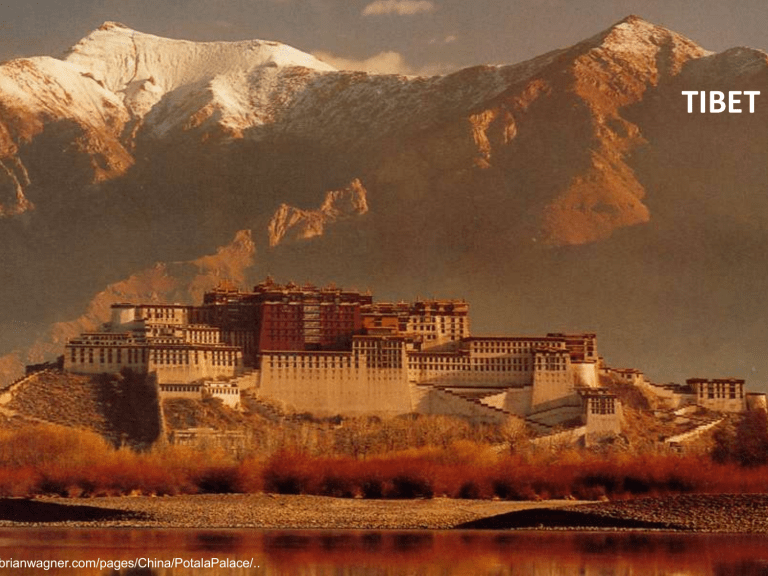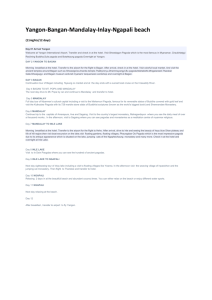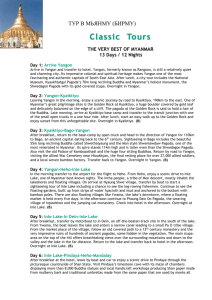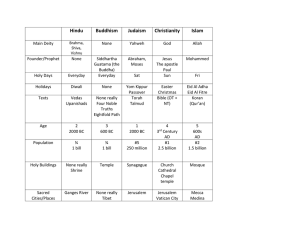
brianwagner.com/pages/China/PotalaPalace/.. TIBET • Tibet sits on the highest plateau in the world, at an average of 12,000 14,000 feet. • Tibet’s high plains, forests and mountains form a unique ecosystem on the planet and are home to an array of rare wildlife, including the snow leopard, blue sheep and Tibetan wild ass. Borders: India - south and west Nepal and Bhutan - south and China - north and east Western Tibet Eastern Tibet Central Tibet • Situated in the Himalayas Five of Asia’s great rivers including: • Indus • Mekong • Brahmaputra Mount Kailash - third and sacred mountain pilgrimage site of Hindu and Bonpo as well as Tibetan PERMAFROST - permanently frozen soil, sediment, or rock, solely based on temperature, not moisture or ground cover. The ground must remain at or below 0°C for at least two years. Stylistic Sources of Art and Architecture 1. INDIAN Art : 11th - 14th 2. NEPALESE Art : 14th -16th 3. CHINESE Ming schools - 15th onwards Buddhism - introduced in towards the end of the 8th c when King Trisong Detsen, invited two Buddhist masters from India. Tibetan Buddhism combined the original, or Mahayanist practices yoga, with tantra, shamanic rituals and elements of an older Tibetan religion known as Bon. Annual Buddhism dancing festival at the Labrang Temple in Xiahe County, northwest China's Gansu Province, Feb. 8, 2009. Monks of the Labrang Temple belonging to the Tibetan Buddhism's Geru Sect perform religionary dance on Sunday to pray for peace and happiness. Prayer flags - Lung-ta, or "Windhorse“ - horse which is both the subduer of evil & the vehicle of enlightenment. One roll of 25 flags strung together showing five traditional designs, each five times. The five colors have many meanings in Tibetan Buddhism - five directions, the five physical elements, the five wisdoms, the five meditation Buddhas, the five mental attributes, or the five realms of existence with blue sky, white cloud, red fire, green water, and yellow earth. Prayer Flags at Namtso, 5,190 meter high Lakenla Pass on the way to Namtso Lake. Found strung along mountain ridge and peaks, to sanctify the surrounding geography. http://phyang.org/photo/tibet.htm Prayer flags are also hoisted on special occasions such as the marriage, new business, new year, childbirth and before opening most important work as it , bring good luck and prosperity. http://architecture.desktopnexus.com/wallpaper/128536/ Buddhist Temple, Lhasa, Tibet Chorten (Tibetan stupa) The Buddha Śākyamuni (Wangdrak) with structural (Jackson, David & Janice. 1984. Tibetan thangka painting: methods and materials. Snow Lion Publications, Ithaca, NY) grid (tigse) Great Stupa at Sanchi, India Chorten or Tibetan stupa • Dagoba or stupa from Sri Lanka Dome is smaller and the spire is more prominent . Chorten (Tibetan) or Stupa (Hindi) 1. Square foundation - symbolizing the earth 2. Dome - symbolizing water 3. 13 tapering steps of enlightenment - symbolizing the element of fire. • Steps lead to a stylized parasol - the symbol of wind, which is topped in the ethereal sphere by the wellknown ‘twin-symbol’ uniting sun and moon, which is the shimmering crown of the Chorten.” Courtesy buddhanet.net Eight different kind stupas, all referring to major events in Buddha Shakyamuni’s life. BUILDING CHARACTER 1. ORGANIC DESIGN to compliment the natural surroundings. 2. Use of natural materials - stone, clay, and wood. 3. Ranging from one to three stories in height. 4. ROOFING • Flat roofs with parapets – in central and western Tibetan plateau with seldom rain. • Sloping roofs covered either in slate, shingles, or ceramic tile. BUILDING CHARACTER 5. Symmetrical in lay-out and façade design. 6. WALLS • Use of stone or rammed earth may be up to a meter thick at the base. • Temples and manor houses - slightly trapezoidal form, heavy at the bottom (stone foundations) and light at the top, generally with battered walls sloping inward to create an illusion of height. BUILDING CHARACTER 7. Windows are usually small because the walls are so heavy that large openings would make the structure weak and unstable. • paper-covered wooden latticework then but was replaced by glass. BUILDING CHARACTER 4. Detailed code for the decoration of doors, windows and parapets (including 5. Painted black frames around doors and windows, and complex wooden overhang decorations), 6. Intricately carved interior timber frame following standardized design principles 7. Organic design – buildings appear to grow out of the landscape POTALA PALACE 1. Outer White Palace - houses the administrative quarters, 2. Inner Red Quarters - houses the assembly hall of the Lamas, chapels, 10,000 shrines and a vast library of Buddhist scriptures. POTALA PALACE :vdare.com/thom/080324_tibet.html • Located on Moburi (Red) Mountain, to the west of old Lhasa 12,000 feet above sea level. POTALA PALACE • 13-storey palace stands 117 meters high and has over 1,000 rooms. • Covers an area of 360,000 square meters. • Made of stone and wood, with walls averaging from 1 – 5 meters thick. commons.wikimedia.org/wiki/File:Potala_Palace... JOKHANG MONASTERY • 1st Buddhist temple in Tibet, located on Barkhor Square in Lhasa. • Built during the reign of king Songsten Gampo (605?-650 CE) to celebrate his marriage with Chinese Tang Dynasty princess Wencheng, who was said to have introduced Buddhism to Tibet. • The temple was called the Tsulag Khang or ‘House of Wisdom’ but it is now known as the Jokhang which means the ‘House of the Buddha’. Heavenly Jokhang Talisman guarding the rooftop of Jokhang, the most revered religious icon of Tibet where hundreds of prostrating pilgrams gathers everyday. One of the many exqusitely-built chorten with delicate images in the Gyantse Kumbum. Best-preserved Monastery Tashilhunpo, seat of the Panchen Lama http://phyang.org/photo/tibet.htm Sky Burial Site A pilgrim surveys the sky burial site at the Lower Ganden Kora (pilgrimage circuit). http://linnil.info/blog/?p=218 (Tagong Temple), built in 641AD. It’s a symbol of the cultural mixture of the nations in China at that time and is one of the most important temples in Tibet. combines the architecture style from both Tibet and China. The high golden tower is a symbol of Tibetan temple while edge of the roof resembles Han Chinese style. MYANMAR (BURMA) Bagan • Called “THE LAND OF PAGODAS” as the landscape is dominated by pagodas or stupas. • ZEDI , Pahto, but are also commonly called Hpaya synonymous with "Buddha“ • Hpongyi Kyaung - monasteries http://www.myanmar-all.com/Myanmar_Pagoda.html Shwedagon Pagoda 6 PERIODS OF THE MYANMAR KINGDOM: 1. PYU ---------------------------- 6th c. until 1044 2. BAGAN AND POST BAGAN ---- 1044 – 1347 cultural peak of the kingdom, evident especially by the vast and magnificent temples. 3. TUNGOO------------------------ 1347 – 1596 4. 2ND/3RD AVA ----------------- 1596 – 1789 5. AMARAPURA ------------------ 1789 – 1853 6. MANDALAY --------------------1853 – 1948 common style associated with Burma, the architecture is similar to the contemporary Thai Rattanakosin style BRITISH COLONIAL ---------------- 1885-1948 Referred to as Post Mandalay • Four most important Burmese Buddhist pilgrimage sites are: 1. Bagan, an ancient capital 2. Kyaiktiyo Pagoda in Mon State 3. Mahamuni Buddha in Mandalay 4. Shwedagon Pagoda in Yangon • Central Burma situated on the left bank of the Ayeyarwaddy River and approximately 90 miles (145 km) southwest of Mandalay. • Site of an ancient capital city in Mandalay • Arimaddanapura or Arimaddana (the City of the Enemy Crusher) • Tambadipa (the Land of Copper) or Tassadessa (the Parched Land) • Pilgrimage centre and contains ancient Buddhist shrines that have been restored and redecorated and are in current use. BAGAN (PAGAN) Images - Photography - Pictures - Buddhism, Bagan, Myanmar, Burma, sunset, by Hartfried Schmid Hartfried Schmid Ananda Temple, Bagan Ananda Temple • • • Completed in 1091 A.D. by King Kyanzittha and modeled after the legendary Nandamula cave in the Himalaya mountains. 51.0 m., and it received its golden gilding in 1990 in commemoration of the 900th anniversary of its construction. Contained within the temple are 4 great statues of the Buddhas. Dhammayangyi, the largest temple in Bagan, built by King Narathu who reigned from 1167 to 1170. Shwezigon Pagoda • Built as the most important reliquary shrine in Bagan. • Begun by King Anawrahta and completed by King Kyanzittha in 1089. It contains several bones and hairs of the Buddha. • Pre-Buddhist Nat worship were combined with Buddhist themes in the pagoda’s construction. Nats are pagan anamistic spirits :www.sacredsites.com/asia/burma/bagan.html Shwezigon Pagoda. Bagan Gawdawpalin, Temple • 60 m. temple built in the 12th c. by King Narapatisithu. Ancient temple in Bagan, Myanmar http://www.scaruffi.com/poetry/images/synall.html Mrauk U, Myanmar Two of the largest abandoned cities in the world lie in Myanmar/Burma. Mahabodhi Temple • • Smaller version of the famous Bodhi temple in Bodh Gaya, India (where the Buddha attained enlightenment beneath the Bodhi tree). Built during the reign of King Nantaungmya (1210-1234) and is completely covered with niches containing seated Buddha figures. Alisin ang frame Kyaiktiyo Pagoda • www.flickr.com/photos/robabbott/406576514 Known as Golden Rock, famous Buddhist pilgrimage site in Mon State, Burma. Kyaiktiyo Pagoda • Believers claim that the large boulder was placed on the cliff 2,500 years ago, by two nats. • Atop the gilded boulder is a 5.5 m (18 ft) pagoda, which is believed to contain a hair of the Buddha. The Mahamuni Buddha, Mandalay • Buddha is housed under a pagoda built in the 1800s. The Mahamuni Buddha, Mandalay • The Great Sage, also known as the Maha Myat Muni Paya, Rakhine Paya, Payagyi, is a major Buddhist pilgrimage site. • Buddha statue was brought from Rakhine State in 1784 by King Bodawpaya as spoils of war. • 4.0 m. high, and the statue is made of bronze, weighing 6.5 tons. The Mahamuni Buddha • Gold leaf is regularly applied to the face of the Mahamuni Buddha, and monks wash the face and teeth of the image each morning. www.flickr.com/photos/libyan_soup/3092309399 Shwedagon Pagoda, Rangoon (Yangon) Shwedagon Pagoda, Rangoon • SHWE - means gold • DAGON - former name of Yangon(Rangoon). www.flickr.com/photos/flappingwings/88846590/ • Shwedagon Pagoda (Main Stupa) - located at the center. • Octagonal base with eight smaller stupas on each of its eight sides, making a total of sixty-four. • Around the Main Stupa - Many pavilions (tazaungs), resting places (zayats), statues, temples, shrines and smaller pagodas. • Manokthihas (sphinxes), surrounded by a number of Manokthihas are found, one at each corner of the platform. Shwedagon Pagoda • Sits on Singuttara Hill and dominates the skyline of Rangoon, Burma. • 98.0 m. (320-360 ft.) high solid gold plated pagoda, covered in 60 tons of gold leaf, Shwedagon Pagoda • The top of the golden stupa (hti or umbrella) is tipped with o 5,448 diamonds o 2,317 rubies o Crowned with a single diamond (sein bu) weighing 76 carats. Eight-Day Symbolism • • • At each cardinal point of the compass Direction Day Planet Sign Around the Shwedagon Pagoda platform are the eight planetary posts representing the eight days of the week S Wed AM Mercury tusked elephant SW W Sat Thu Saturn Jupiter naga rat NW Wed PM Yahu tuskless elephant (Wednesday is divided into a.m. and p.m. making it two days), each with its own planet and animal symbol. Beside each planetary post is a gilded Buddha figure made of alabaster. N Fri Venus guinea pig or mole NE Sun Sun garuda E SE Mon Tue Moon Mars tiger lion Shwedagon Pagoda Shwedagon Pagoda http://afewroundsmore.wordpress.com/ Monasteries, Pagodas and Stupas http://afewroundsmore.wordpress.com/ Monastery of Popa Taungkalat 2,417 feet, an ancient, sheer-sided volcanic plug. http://sandysdreamzunlimited.blogspot.com/2009/10/gigantic-lava-plug-budhhist-monastery.html http://sandysdreamzunlimited.blogspot.com/2009/10/gigantic-lava-plug-budhhistmonastery.html The monastery of Taung Kalat is also home to the 37 Mahagiri Nats – spirits of humans who met violent deaths revered in conjunction with Buddhism – their statues to be found at the base of the Shrine. http://sandysdreamzunlimited.blogspot.com/2009/10/gigantic-lava-plug-budhhistmonastery.html M A Bhanpurwala Ngaphechaung Monastery • Wooden monastery is built on stilts and is located in Inle Lake. • Built in the 1850s, it is now home to numerous Buddhas as well as cats that are trained to jump through hoops. Shwenandaw Kyaung • Monastery built of wood, and is one of the oldest wooden buildings in Mandalay that was spared from damage during the WW II. • Originally located within the grounds of Mandalay Palace. Shwenandaw Kyaung • Intricate woodcarvings ornamentation of figures and flowers. • Walls were once gold plated and adorned with glass mosaic, both inside and outside. Multi-tiered teak wooden structure with four separate “Zeitawun” roof levels. Wood carving - statue depicting serene Burmese Angels on Door of Shwe-In Temple, Mandalay www.flickr.com/photos/10186213@N07/2343507397/ Kyauktawgyi Paya Temple with colored glass artwork, Mandalay Mandalay Palace Mandalay Palace was burned to the ground during World War 2. It was rebuild over the last 10 years based on photographs and British and Burmese records. Mandalay Palace Mandalay Palace http://www.worldisround.com/articles/60407/photo8.html http://afewroundsmore.wordpress.com/ Shwe in Bin Monastery, Mandalay http://afewroundsmore.wordpress.com/ Detail of one level in the many tiers of the pyramidal roof Art Deco Colonial Building, Rangoon Houses http://afewroundsmore.wordpress.com/ http://afewroundsmore.wordpress.com/ Mandalay Resort



